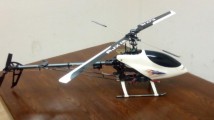Abstract
This paper introduces a custom experimental test bed for the evaluation of autonomous flight controllers for unmanned helicopters. The development of controllers for unmanned helicopters is a difficult procedure which involves testing through simulation at first, and then actual experimentation on real vehicles. As simulation cannot accurately represent the exact real flight conditions and the dangers involved in them, the suggested test bed fills the gap between simulation runs and experimental flights. The developed system involves a small helicopter mounted on a flying stand, equipped with a set of sensors for real-time flight monitoring and control. For demonstration purposes, the test bed has been used for design and validation of a fuzzy logic based autopilot, able to perform hovering and altitude control. Experimental results are presented and commented for various test cases.
Similar content being viewed by others
References
Spanoudakis, P., Doitsidis, L., Tsourveloudis, N.C., Valavanis, K.P.: The market for VTOL UAVs. Unmanned Syst. Mag. 21(5), 14–18 (2003)
Kontitsis, M., Valavanis, K.P., Garcia, R.: A simple low cost vision system for small unmanned VTOL vehicles. In: Proceedings of the IEEE/RSJ International Conference on Intelligent Robots and Systems, pp. 3480–3486. Alberta, Canada (2005)
Roberts, J.M., Corke, P.I., Buskey, C.: Low-cost flight control system for a small autonomous helicopter. In: Proceedings of the IEEE International Conference on Robotics and Automation, pp. 546–551. Taipei, Taiwan (2003)
Tanaka, K., Ohtake, H., Wang, H.O.: A practical design approach to stabilization of a 3-DOF RC helicopter. IEEE Trans. Contr. Syst. Technol. 12(2), 315–325 (2004). doi:10.1109/TCST.2003.821963
Andrievsky, B., Peaucelle, D., Fradkov, A.L.: Adaptive control of 3DOF motion for LAAS helicopter benchmark: design and experiments. In: Proceedings of the 2007 American Control Conference p. 6. New York City, USA (2007)
Kutay, A.T., Calise, A.J., Idan, M., Hovakimyan, N.: Experimental results on adaptive output feedback control using a laboratory model helicopter. IEEE Trans. Contr. Syst. Technol. 13(2), 196–202 (2005). doi:10.1109/TCST.2004.839563
Dzul, A., Lozano, R., Castillo, P.: Adaptive control for a radio-controlled helicopter in a vertical flying stand. Int. J. Adapt. Control Signal Process. 18(5), 473–485 (2004). doi:10.1002/acs.808
Mancini, A., Caponetti, F., Monteriu, A., Frontoni, E., Zingaretti, P., Longhi, S.: Safe flying for an UAV Helicopter. In: Proceedings of the 15th Mediterranean Conference on Control & Automation, Athens, Greece (2007)
Whiteman, R.: Training apparatus for remote control model helicopters. United States Patent No. 4,917,610 (1990)
Pallet, T.J., Ahmad, S.: Real-time helicopter flight control: modelling and control by linearization and neural networks. ECE Technical Reports, Purdue University (1991)
Brock, K.: Development of an autonomous robotic aerial vehicle. IARC Annual Papers (2002)
Hanford, S.D., Long, L.N., Horn, J.F.: A small semi-autonomous rotary-wing unmanned air vehicle (UAV). In: AIAA Infotech@Aerospace, Washington DC, USA (2005)
Kim, H.J., Shim, D.H.: A flight control system for aerial robots: algorithms and experiments. Control Eng. Pract. 11(12), 1389–1400 (2003). doi:10.1016/S0967-0661(03)00100-X
Shin, J., Nonami, K., Fujiwara, D., Hazawa, K.: Model-based optimal attitude and positioning control of small-scale unmanned helicopter. Robotica 23(01), 51–63 (2005). doi:10.1017/S026357470400092X
Kim, N., Calise, A., Corban, J., Prasad, J.: Adaptive output feedback for altitude control of an unmanned helicopter using rotor RPM. In: Proceedings of the AIAA Guidance Navigation and Control Conference and Exhibit, pp. 2004–5323. Rhode Island, USA (2004)
Merz, T., Duranti, S., Conte, G.: Autonomous landing of an unmanned helicopter based on vision and inertial sensing. In: Experimental Robotics IX: The 9th International Symposium on Experimental Robotics, pp. 343–352 (2006)
Saripalli, S., Sukhatme, G.S., Montgomery, J.F.: An experimental study of the autonomous helicopter landing problem. Experimental Robotics VIII, pp. 466–475 (2003)
Valenti, M., Bethke, B., Fiore, G., How, J.P.: Indoor multi-vehicle flight testbed for fault detection, isolation, and recovery. In: AIAA Guidance, Navigation, and Control Conference and Exhibit, Keystone, Colorado (2006)
Doitsidis, L., Valavanis, K.P., Tsourveloudis, N.C., Kontitsis, M.: A framework for fuzzy logic based UAV navigation and control. In: Proceedings of the IEEE International Conference on Robotics and Automation, pp. 4041–4046. New Orleans, USA (2004)
Tsourveloudis, N.C., Doitsidis, L., Valavanis, K.P.: Autonomous navigation of unmanned vehicles: a fuzzy logic perspective. In: Cutting Edge Robotics, pp. 291–310 (2005)
Tsourveloudis, N.C., Valavanis, K.P., Hebert, T.: Autonomous vehicle navigation utilizing electrostatic potentialfields and fuzzy logic. IEEE Trans. Robot. Autom. 17(4), 490–497 (2001). doi:10.1109/70.954761
Author information
Authors and Affiliations
Corresponding author
Rights and permissions
About this article
Cite this article
Vitzilaios, N.I., Tsourveloudis, N.C. An Experimental Test Bed for Small Unmanned Helicopters. J Intell Robot Syst 54, 769–794 (2009). https://doi.org/10.1007/s10846-008-9284-8
Received:
Accepted:
Published:
Issue Date:
DOI: https://doi.org/10.1007/s10846-008-9284-8




